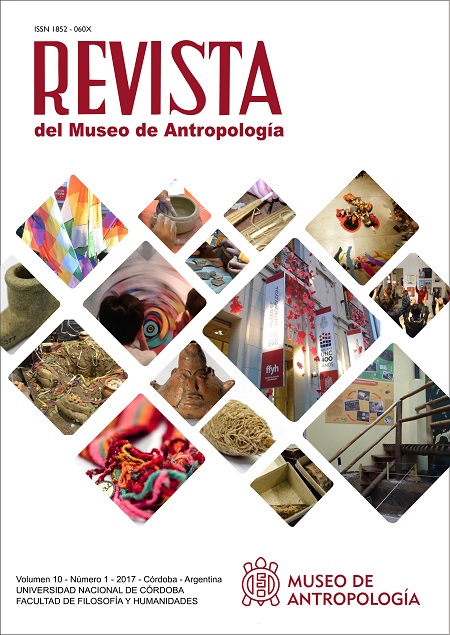Form Analysis of Ceramic Vessels from Museums of Southern Mendoza
DOI:
https://doi.org/10.31048/1852.4826.v10.n1.13261Keywords:
museums, ceramic vessels, form, function, southern MendozaAbstract
A study of vessel form of three museums from Southern Mendoza was performed. Its main objective was to know the kind of forms that are present in the region, and to provide, from the results obtained, a comparative sample to analyze archaeological ceramic sherds. This work arises from high ceramic fragmentation and absence of entire vessels in archaeological sites. Accordingly, a data file was developed on the basis of variables that consider technological aspects and that are related to mobility of human populations. Form-function relation was also conducted in order to evaluate the role played by ceramic technology from trends noticed in Southern Mendoza. Results show high morphological variability in the region probably linked to the possibilities of use and to the archaeological expectations expected from mobile hunter-gatherer populations.Downloads
References
Arnold, D. 1985. Ceramic theory and cultural process. New Studies in Archaeology. Cambridge University Press.
Beck, M.E. 2009. Residential mobility and ceramic exchange: Ethnography and archaeological implications. Journal of Archaeological Method and Theory, 16(4): 320-356.
Canals Frau, S. 1956. Algunos Aspectos de la Cultura de Agrelo. Anales de Arqueología y Etnología.
Costin, C.L. 2001. Craft production systems. Feinman y Price Eds. Archaeology at the Millennium: A Sourcebook. Capítulo 8: 273-327. Kluwer Academic/Plenum Publishers, New York.
Durán, V. y J. Ferrari. 1991. El proceso de araucanización del sur mendocino desde una perspectiva arqueológica. Actas del XI Congreso Nacional de Arqueología Chilena III: 165-188. Chile.
Eerkens, J. 2001. “The origins of pottery among late prehistoric hunter-gatherers in California and the Western Great Basin”. University of California. Santa Bárbara. USA. 291. PhD Dissertation.
2003. Residential mobility and pottery use in the Western Great Basin. Current Anthropology. 44 (5):728-738.
2012. A model for predicting economic interaction in arid lands and an evaluation in Eastern California based on brownware ceramics. D. Rhode (Ed.). Meet at the margins. Prehistoric cultural interaction in the intermountain west. 229-245. Utah Press.
Falabella, F. y L. Stehberg.1989. Cap. 14. El periodo Agroalfarero Medio en Chile Central. Culturas de Chile. Prehistoria. Desde sus orígenes hasta los albores de la conquista. Hidalgo, J., V. Schiapacasse, H. Niemeyer, C. Aldunate I. Solimano (eds.). 295-311. Editorial Andrés Bello, Santiago.
Franchetti, F. y N. Sugrañes. 2014. Pots in Northern Patagonia: Design characteristics, functionality and variability. 79th Society for American Archaeology Annual Meeting. Austin, Texas, USA.
Henrikson, E. y M. McDonald. 1983. ceramic form and function: an ethnographic search and an archaeological application. American Anthropologist 85: 630-643.
Lagiglia, H. 1977. “Arqueología y ambiente natural de los valles del Atuel y del Diamante”. 2 tomos. Tesis Doctoral Nº 353. Facultad de Ciencias Naturales y Museo, Universidad Nacional de La Plata.
Lagiglia, H. 1997. Arqueología de cazadores recolectores cordilleranos de altura. San Rafael: Ediciones Ciencia y Arte.
Massone, M. 1980. Nuevas consideraciones en torno al complejo Aconcagua. Revista Chilena de Antropología Nº 3: 75-80. Santiago, Chile.
Neme, G. y A. Gil. 2012. El registro arqueológico del sur de Mendoza en perspectiva biogeográfica. Neme, G. y A. Gil (Eds.). Paleoecología humana en el sur de Mendoza. Perspectivas arqueológicas. 255-279. SAA. Buenos Aires.
Orton, C, y A. Tyers, A., Vince. 1993. Cerámica en Arqueología. Barcelona: Ed. Crítica.
Prieto Olavarría, C. 2012. La producción y función de la cerámica indígena durante la dominación incaica y la colonia en Mendoza (Argentina). Intersecciones en Antropología 13: 71-87.
Renfrew, C. 1977. Alternative models for exchange and spatial distribution. Earle, T.K., Ericson, J.E. (Eds.). Exchange Systems in Prehistory. 71-90. Academic Press. New York.
Rice, P. 1987. Pottery analysis. The University of Chicago Press.
Rye, O.1988. Manual on Archaeology 4. Pottery Technology. Principles and Reconstruction. Australian National University, Taraxacum, Washington.
Rusconi, C. 1962. Poblaciones pre y pos hispánicas de Mendoza. II Arqueología. Mendoza.
Shepard, A. 1985 [1956]. Ceramics for the archaeologist. Publication 609. Carnegie Institution of Washington, Washington D.C.
Simms, S. y J. Brigth, A. Ugan. 1997. Plain- ware ceramics and residential mobility: A case study from the great Basin. Journal of Archeological Science 24:779-792.
Sinópoli, C. 1991. Approaches to archaeological ceramics. Plenum Press. New York.
Skibo, J. M. 1992. Pottery function. A use-alteration perspective. Plenum Press. New York y London.
Smith, M. 1985. Toward an economic interpretation of ceramics: relating vessel size and shape to use. Nelson, B. Ed. Decoding Prehistoric Ceramics. 254-309. Southern Illinois University Press. Carbondale.
Stark, M. 1991. Ceramic production and community specialization: A Kalinga ethnoarchaeological study. World Archaeology 23 (1):64-78.
Sugrañes, N. y F. Franchetti. 2012. Antecedentes, problemas y perspectivas del análisis cerámico en el sur de Mendoza. Una puesta al día. Neme, G. y A. Gil (Eds.). Paleoecología Humana en el Sur de Mendoza: Perspectivas Arqueológicas. 229-253. Sociedad de Antropología Argentina. Buenos Aires.
Downloads
Published
Issue
Section
License
Those authors who have publications with this Journalaccept the following terms:
a. Authors will retain their copyrights and guarantee the journal the right of first publication of their work, which will be simultaneously subject to the Creative Commons Attribution License (Licencia de reconocimiento de Creative Commons) that allows third parties to share the work as long as its author and his first publication in this journal.
b. Authors may adopt other non-exclusive licensing agreements for the distribution of the version of the published work (eg, deposit it in an institutional electronic file or publish it in a monographic volume) provided that the initial publication in this journal is indicated.
c. Authors are allowed and recommended to disseminate their work on the Internet (eg in institutional telematic archives or on their website) before and during the submission process, which can lead to interesting exchanges and increase citations of the published work. (See The Effect of Open Access - El efecto del acceso abierto)












